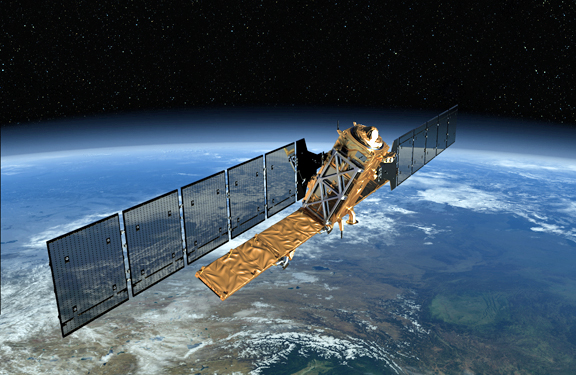On April 22, 2016, at 22:00 Central European Time, Sentinel-1B will be carried into space by a Soyuz rocket launched from the European spaceport in Kourou, French Guiana.
As was the case for its Sentinel-1A twin, RUAG Space again made a major contribution to the development and construction of the new environmental satellite. The Sentinels are the centerpiece of Europe’s Copernicus Earth observation program, with which the European Union creates a modern and efficient infrastructure for Earth observation and geo-information services.

Artistic rendition of a Sentinel 1 satellite.
Image is courtesy of ESA.
The Sentinel satellite family will deliver data for a variety of environmental and safety-related applications, including detecting oil spills, mapping sea ice, monitoring the movement of land masses and mapping trends in land use. Additionally, Sentinel-1b will support disaster relief and humanitarian crisis response by providing Earth observation data. Offset by 180 degrees, the two Sentinel-1 satellites will circle the Earth on the same orbit. This means that the satellites will fly over the same areas of the Earth’s surface in quick succession. Thanks to the consequent doubling of the scanning rate and acquisition capacity, it will now be possible to remap the Earth every six days.
As part of an international industrial consortium led by Thales Alenia Space, RUAG Space plays a major role in the satellite project. Knowing where the satellite is at any given time is a prerequisite for ensuring its measurements are precise. That’s why the satellites use signals from the United States’ GPS (global positioning system) satellite navigation system for attitude control. The GPS receiver developed by RUAG Space in Vienna is tailored to meet precise orbit determination (POD) requirements in space. Unlike the GPS receivers commonly used in terrestrial applications, these devices are capable of simultaneously processing signals received at two different frequencies, and thus delivering positioning information of the highest accuracy.
A laser terminal on board of the satellite will make it possible in the future for satellites to send data over an optical connection to the European Data Relay System (EDRS). This new technology lets satellites send substantially more data than is possible with a standard direct radio link with the Earth. RUAG Space supplied the telescope assembly for Sentinel-1b’s laser communication terminal.
RUAG Space was also responsible for producing the satellite’s aluminum and carbon fiber structure. Comparable to the chassis of a car, this structure forms the “backbone” of the satellite onto which all other components are mounted. RUAG Space also provided the thermal insulation for the Sentinel-1b satellite.
In addition RUAG Space manufactured a number of electronic modules for controlling and tracking the satellite in orbit. The radar antenna features another 28 RUAG electronics modules, which are used to direct the radar beam. The electronics modules that generate the radar signal were also supplied by RUAG Space.


